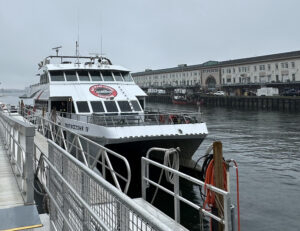PROVINCETOWN — This year has proved especially lethal for the critically endangered North Atlantic right whale, with the discovery on March 30 of a dead female marking the fifth mortality or serious injury this year in a population of only around 360 individuals. The biggest immediate threats to the right whales’ survival are entanglement in fishing gear and ship collisions, according to the National Oceanic and Atmospheric Administration.
In September 2022, NOAA Fisheries proposed changes to its North Atlantic Right Whale Vessel Strike Reduction Rule aimed at preventing ship strikes by lowering vessel speeds. The amended rule is in the final stage of executive review, and officials are worried it will have dire effects on the local economy — both on the ferry services that bring visitors to Provincetown every summer and, more broadly, on the business those visitors bring to the town.
Currently, all vessels over 65 feet long must obey a 10-knot-per-hour speed limit within specific zones at specific times of year — around here, those are Jan. 1 to May 15 in Cape Cod Bay and March 1 to April 15 off Race Point. Current regulations also create “dynamic management areas,” 400-square-nautical mile areas that are established for two weeks when right whales are sighted outside these zones; in these areas, NOAA suggests ‑ but does not mandate ‑ that boats stay below 10 knots per hour.
The proposed amendments to the rule would impose a 10-knot-per-hour speed limit along the East Coast from Massachusetts to North Carolina between Nov. 1 and May 30, which would apply to all boats at least 35 feet in length. Additionally, the dynamic management areas would become mandatory.
The amended rule was moved to the executive branch’s Office of Information and Regulatory Affairs on March 5. If it is passed there, it will become law.
Michael Glasfeld, owner of Bay State Cruise Company, which runs round-trip ferries between Boston and Provincetown three times a day in the summer, said that extending the speed limit period from May 15 to May 30 would cause his business to lose about half its annual profits. Expenses like insurance and mortgages have to be paid throughout the year, he said, and “every week we operate is critical for paying down all that money.”

During the initial public comment period on this legislation in 2022, Provincetown Town Manager Alex Morse wrote a letter focusing his concern on extending the speed limit to May 30. Morse said that each ferry-based day tripper spends $450 in town, and a visitor who stays for a week spends $6,500.
U.S. Rep. Bill Keating also wrote a letter that year expressing his concern about the broader effects of the rule change, arguing that Provincetown could lose as much as $100 million in revenue if the three ferry companies that serve the town were to go out of business.
Glasfeld argues that right whales mostly leave Cape Cod Bay by May 15, so the extension of the restricted period is unnecessary.
Charles “Stormy” Mayo, the Director of the Right Whale Ecology Program at the Center for Coastal Studies, agreed that most right whales leave the bay by the middle of May. He added, however, that his organization’s data suggest that the whales are departing later and later each year.
“We have to take really drastic measures in order to save the species from extinction,” said Erica Fuller, senior counsel at the Conservation Law Foundation, which filed suit against NOAA in February to expedite the passage of the vessel speed rule. She said that the only proven way to mitigate right whale death is a 10-knot-per-hour limit.
Regina Asmutis-Silva, executive director of the nonprofit Whale and Dolphin Conservation, which also took part in the lawsuit, argued that the update is needed because right whales have changed where they live and forage since the original rule was passed in 2008.
The mandatory dynamic management amendment is what most concerns Glasfeld, he said. If the presence of right whales were to trigger one of these areas in Cape Cod Bay during the summer, he said, it could turn a 90-minute one-way trip into a 4.5-hour one. This, he said, would amount to “millions of dollars lost,” which he said would put the ferry services out of business.
Two conditions must be met for a slow zone to be triggered. First, a pod of at least three right whales must be detected visually, or a right whale must be detected acoustically. Then NOAA must determine that the whales appear to be staying in the area for at least 10 days, not just transiting through.
Because of these conditions, the odds of a slow zone being triggered are low, Mayo said. He noted, though, that in 1986 a pod of 13 right whales stayed in Cape Cod Bay throughout the summer.
Further amendments could still be made to the rule before it is adopted. Fuller suggested that the extension of the speed limit from May 15 to May 30 could be removed, and that her organization would support that.
Glasfeld also said that he would support the dynamic management areas if they were shrunk to a “navigable” 100 square nautical miles, but both Fuller and Asmutis-Silva said that the dynamic management areas are supported by the best available science.
When it comes to preventing right whale deaths, Mayo said, “there’s no magic bullet.” Nonetheless, he said, speaking from his perspective, he hopes that NOAA makes a decision “with an understanding that the animals are nearly extinct, and we’ve got to do something or they will be gone.”
